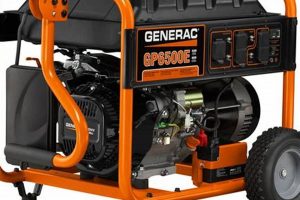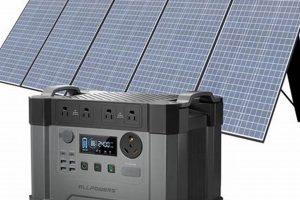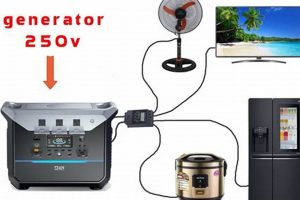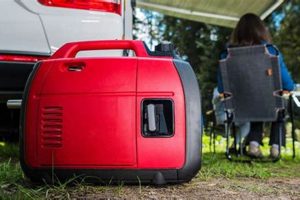Compact, independent power sources, often fueled by gasoline or propane, offer a temporary electrical supply during outages or in off-grid locations. These units can power essential appliances like refrigerators, lights, and small electronics, ensuring a degree of normalcy during disruptions.
The availability of backup power provides crucial peace of mind, safeguarding against food spoilage, communication blackouts, and disruptions to medical equipment. Historically, reliance on centralized grids has left consumers vulnerable to widespread outages caused by natural disasters or grid failures. These self-contained units offer a practical solution, bridging the gap between utility dependence and individual resilience.
Understanding the various types, sizes, and functionalities available is essential for informed decision-making. The following sections will delve into selecting the appropriate power output, fuel type, and features to match specific needs and circumstances.
Operating Backup Power Supplies Safely and Effectively
Safe and efficient operation of independent power sources requires careful planning and adherence to safety guidelines. These tips offer practical advice for maximizing utility and minimizing risks.
Tip 1: Calculate Power Needs: Determine the wattage requirements of essential appliances to select a unit with sufficient capacity. Overloading can damage both the unit and connected devices.
Tip 2: Proper Ventilation is Crucial: Operate units outdoors in well-ventilated areas to prevent carbon monoxide buildup. Never run them indoors or in enclosed spaces.
Tip 3: Safe Fuel Handling: Allow the unit to cool completely before refueling. Store fuel in approved containers away from ignition sources. Never refuel a running unit.
Tip 4: Regular Maintenance: Follow manufacturer recommendations for oil changes, air filter cleaning, and other routine maintenance to ensure optimal performance and longevity.
Tip 5: Dry Location is Essential: Protect the unit from rain and moisture. Operating in wet conditions can create electrical hazards.
Tip 6: Connection Considerations: Use heavy-duty extension cords rated for the unit’s output. Avoid connecting directly to household wiring unless through a properly installed transfer switch.
Adhering to these guidelines ensures safe and reliable power during emergencies. Careful planning and preventative maintenance contribute significantly to the longevity and effective use of these devices.
By understanding these operational best practices, consumers can confidently utilize backup power, enhancing safety and preparedness for unforeseen circumstances.
1. Power Output
Power output, measured in watts, represents a critical specification for portable generators intended for home use. This metric directly determines the number and type of appliances that can be powered simultaneously. A generator’s power output must exceed the combined wattage requirements of all intended devices to prevent overload and ensure safe operation. For instance, a refrigerator might require 700 watts, while a sump pump might need 1000 watts. Attempting to run both simultaneously on a 1500-watt generator risks overloading the unit, potentially causing damage or shutdown. Conversely, a generator with a significantly higher wattage capacity, such as 5000 watts, provides ample power for multiple appliances, including larger electronics or power tools.
Understanding power output facilitates informed generator selection. Consumers must carefully assess their power needs based on anticipated usage scenarios. This involves identifying essential appliances and calculating their combined wattage. Choosing a generator with adequate power output ensures uninterrupted operation of crucial devices during outages, mitigating inconvenience and potential safety risks. Overestimating power needs slightly provides a safety margin for unforeseen requirements. However, excessively high power output often translates to increased fuel consumption and higher operating costs. Therefore, a balanced approach, aligning power output with realistic needs, optimizes efficiency and cost-effectiveness.
Careful consideration of power output contributes significantly to effective generator utilization. Matching power supply with demand ensures reliable performance, prevents equipment damage, and maximizes the generator’s functional lifespan. This understanding empowers consumers to make informed decisions, optimizing preparedness for power disruptions while managing operational costs.
2. Fuel Type
Fuel type significantly influences the practicality and operational costs of portable generators for home use. Common fuel types include gasoline, propane, and diesel. Each presents distinct advantages and disadvantages impacting generator selection. Gasoline offers widespread availability and generally lower upfront generator costs. However, it deteriorates over time, requiring periodic replacement and posing storage challenges. Propane offers longer shelf life, cleaner burning, and easier storage, but propane-powered generators typically have higher initial costs. Diesel provides exceptional fuel efficiency and long run times, making it suitable for extended outages, but diesel generators tend to be larger, heavier, and more expensive.
The choice of fuel type hinges on specific needs and circumstances. Gasoline suits occasional use and shorter outages, while propane provides a reliable option for longer-term storage and less frequent operation. Diesel caters to extended power disruptions and demanding applications requiring sustained performance. Fuel availability and local regulations also play a role. For instance, during natural disasters, gasoline shortages may occur, making propane or diesel more practical options. Furthermore, some areas may have restrictions on fuel storage, influencing the feasibility of certain fuel types. Evaluating these factors ensures alignment between fuel choice and operational requirements.
Effective generator selection necessitates careful consideration of fuel type alongside power output, run time, and other critical specifications. Understanding the nuances of each fuel type, considering storage requirements, operational costs, and potential availability issues, empowers informed decisions. This knowledge ensures reliable power generation during emergencies, minimizes operational challenges, and maximizes the generator’s functional lifespan within specific environmental and logistical contexts.
3. Run Time
Run time represents a crucial factor influencing the practical utility of a portable generator for home use. Defined as the duration a generator can operate continuously on a single fuel tank, run time directly impacts preparedness for extended power outages. A generator with a short run time, for example, four hours, necessitates frequent refueling, posing logistical challenges during extended emergencies or when fuel availability is limited. Conversely, a generator offering a longer run time, such as ten hours or more, provides sustained power, reducing refueling frequency and enhancing overall reliability. Factors impacting run time include fuel tank capacity, engine efficiency, and load. Larger fuel tanks generally contribute to longer run times, while higher loads, representing increased power demand, typically reduce run time. Manufacturers often specify run time at various load levels, allowing consumers to estimate operational duration under different usage scenarios. For instance, a generator might run for ten hours at 25% load, but only five hours at 75% load.
Understanding the relationship between run time and load enables realistic planning for power disruptions. Consider a household requiring power for essential appliances like a refrigerator, a few lights, and a furnace fan during a winter storm. Calculating the combined wattage of these appliances determines the load. Selecting a generator with sufficient run time at that load ensures uninterrupted power throughout the anticipated outage duration. Practical implications extend beyond convenience. Extended run times can be critical for maintaining essential services during prolonged emergencies, impacting food preservation, communication, and safety. Furthermore, longer run times minimize disruptions caused by refueling, particularly during inclement weather or when fuel access is restricted.
Run time constitutes a critical element within portable generator specifications. Effective preparedness hinges on understanding the interplay between run time, fuel tank capacity, and load. Matching run time capabilities with anticipated outage durations and power demands ensures reliable performance, mitigates logistical challenges associated with refueling, and enhances overall resilience during power disruptions.
4. Noise Level
Noise level represents a significant consideration when evaluating portable generators for home use. Measured in decibels (dB), this metric indicates the sound intensity produced during operation. Generators, particularly those powered by gasoline, can generate substantial noise, ranging from a low hum to a loud roar, potentially disrupting household activities, disturbing neighbors, and violating local noise ordinances. Noise levels vary significantly depending on generator size, engine design, and load. Larger generators generally produce more noise than smaller ones. Furthermore, some manufacturers incorporate noise-reduction technologies, such as mufflers and sound-dampening enclosures, to mitigate operational noise. Understanding the noise level of a prospective generator is essential for ensuring compatibility with residential environments and maintaining amicable neighborhood relations. For instance, operating a loud generator late at night in a densely populated area could lead to noise complaints and potential fines. Conversely, a quieter generator minimizes disturbances and promotes harmonious co-existence within residential settings.
The practical implications of generator noise extend beyond immediate surroundings. Operating a loud generator near open windows can disrupt sleep and hinder concentration. In rural settings, excessive noise may disturb wildlife or interfere with outdoor activities. Furthermore, prolonged exposure to high noise levels can pose health risks, including hearing damage and stress. Therefore, evaluating noise levels contributes to both environmental responsibility and personal well-being. Consulting manufacturer specifications, reading online reviews, and comparing models in person allows consumers to assess noise output before purchase. Some retailers even offer sound demonstrations, allowing prospective buyers to experience the generator’s operational noise firsthand. This informed approach ensures compatibility with individual needs and promotes responsible generator usage within residential communities.
Noise level constitutes a critical factor influencing generator selection. Understanding the potential impact of generator noise on household tranquility, neighborhood harmony, and personal well-being empowers informed decision-making. By carefully evaluating noise levels and considering noise-reduction features, consumers can select generators that minimize disruptions and promote responsible operation within residential environments, balancing power needs with community considerations.
5. Portability
Portability defines a key characteristic of home generators designed for mobile use. This attribute distinguishes them from permanently installed standby generators, enabling convenient transport and deployment in various scenarios. Portability hinges on factors such as weight, size, and integrated handling features. Lightweight, compact designs facilitate easy movement by a single individual, while larger, heavier units might require two people or wheeled transport. Integrated handles, wheels, and lifting points enhance maneuverability, simplifying transport over uneven terrain or up stairs. This inherent mobility expands the potential applications of portable generators beyond emergency home backup power to encompass recreational activities, remote work sites, and temporary power solutions in diverse locations. For instance, a portable generator can power essential equipment during camping trips, provide electricity at outdoor events, or operate tools at construction sites lacking grid access.
The practical significance of portability extends to emergency preparedness. During natural disasters or widespread power outages, access to electricity becomes critical for maintaining essential services. A portable generator can be readily deployed to power refrigerators, sump pumps, or medical equipment, mitigating risks associated with food spoilage, flooding, or disruptions to essential medical devices. Furthermore, portability allows for flexible relocation of the generator to power different appliances or areas as needed. For example, during a prolonged outage, a portable generator could be used to power a refrigerator during the day and then moved to power lighting and heating at night. This adaptability enhances the utility of portable generators in dynamic emergency situations.
Portability represents a defining feature of generators intended for mobile power supply. This characteristic enhances versatility, enabling diverse applications ranging from recreational use to emergency preparedness. Factors such as weight, size, and integrated handling features directly influence the practicality of transport and deployment. Understanding the interplay of these elements empowers informed generator selection, ensuring alignment between portability requirements and specific usage scenarios. The inherent mobility of portable generators expands their functional scope, bridging the gap between stationary power sources and the dynamic demands of diverse applications, ultimately enhancing resilience and self-sufficiency in various contexts.
6. Safety Features
Safety features represent critical components of portable generators intended for home use, mitigating potential hazards associated with operation. These features safeguard both users and connected appliances from electrical shocks, fires, and carbon monoxide poisoning. Key safety features include overload protection, low-oil shutoff, and carbon monoxide detectors. Overload protection prevents damage to the generator and connected devices by automatically shutting down the unit when electrical demand exceeds its capacity. This prevents overheating and potential fires. Low-oil shutoff safeguards the engine from damage by automatically turning off the generator when oil levels drop below a critical threshold. This prevents engine seizure and extends the generator’s lifespan. Carbon monoxide detectors integrated into some portable generators provide an additional layer of safety by monitoring carbon monoxide levels and triggering an alarm when dangerous concentrations are detected. This feature mitigates the risk of carbon monoxide poisoning, a colorless, odorless gas produced during fuel combustion. For instance, if a generator is operated in a poorly ventilated area, carbon monoxide can accumulate, posing a serious health risk. The integrated detector provides a crucial warning, allowing users to take corrective action.
The practical significance of these safety features underscores the importance of selecting generators equipped with comprehensive safeguards. Operating a generator lacking essential safety features increases the risk of accidents and equipment damage. For example, a generator without overload protection could overheat and catch fire if overloaded. A generator without a low-oil shutoff could suffer irreversible engine damage if operated with insufficient oil. Furthermore, operating a generator without a carbon monoxide detector in a confined space poses a severe risk of carbon monoxide poisoning. Real-world incidents highlight the potential consequences of neglecting safety features. Numerous reports document fires caused by overloaded generators, engine damage due to low oil levels, and fatalities resulting from carbon monoxide poisoning. These examples underscore the critical role of safety features in mitigating potential hazards.
Careful consideration of safety features constitutes a crucial element in responsible generator selection and operation. Prioritizing models equipped with comprehensive safeguards mitigates risks, protects users and equipment, and promotes safe electricity generation during power outages or off-grid activities. Understanding the function and importance of each safety feature empowers informed decision-making, enhancing overall safety and preparedness. Ignoring safety features can have severe consequences, ranging from equipment damage to life-threatening situations. Therefore, a proactive approach to safety, coupled with adherence to operational guidelines, ensures responsible and hazard-free generator utilization.
7. Maintenance
Regular maintenance is essential for ensuring the reliable and long-lasting performance of a portable generator intended for home use. Neglecting routine maintenance can lead to decreased efficiency, mechanical failures, and potentially hazardous operating conditions. A well-maintained generator provides consistent power during outages, maximizing its functional lifespan and minimizing the risk of unexpected breakdowns.
- Oil Changes
Regular oil changes are crucial for lubricating engine components and preventing premature wear. Engine oil degrades over time, losing its lubricating properties and accumulating contaminants. Failing to change the oil as recommended by the manufacturer can lead to increased friction, overheating, and ultimately engine damage. Consult the generator’s owner’s manual for the recommended oil type and change intervals. For instance, a generator might require an oil change every 50 hours of operation or annually, whichever comes first. Adhering to this schedule ensures optimal engine lubrication and prolongs its operational life.
- Air Filter Cleaning/Replacement
Clean air filters are essential for optimal engine performance and fuel efficiency. A clogged air filter restricts airflow to the engine, reducing combustion efficiency and increasing fuel consumption. This can lead to decreased power output and potentially engine damage. Regularly inspect the air filter and clean or replace it as needed. The frequency of cleaning or replacement depends on operating conditions. Generators used in dusty environments require more frequent air filter maintenance. Refer to the owner’s manual for specific cleaning and replacement instructions.
- Spark Plug Inspection/Replacement
Spark plugs ignite the fuel-air mixture in the engine cylinder. Worn or fouled spark plugs can cause misfires, reduced power output, and increased fuel consumption. Regularly inspect the spark plugs and replace them as needed. The recommended replacement interval varies depending on the generator model and usage. Consult the owner’s manual for specific spark plug replacement guidelines. Using the correct type of spark plug ensures optimal engine performance and reliability.
- Fuel System Maintenance
Proper fuel system maintenance prevents fuel-related issues that can affect generator performance and reliability. Gasoline can deteriorate over time, forming gum and varnish deposits that can clog fuel lines and carburetor jets. This can lead to starting difficulties, rough running, and reduced power output. Using fuel stabilizer can help prevent fuel degradation during storage. Additionally, draining the fuel system before long-term storage prevents stale fuel from causing problems. Periodically inspect and clean the fuel lines, fuel filter, and carburetor to ensure proper fuel flow and prevent blockages. Consult the owner’s manual for specific fuel system maintenance recommendations.
Adhering to a comprehensive maintenance schedule ensures the reliable and efficient operation of a portable generator for home use. Regular maintenance not only extends the generator’s lifespan but also minimizes the risk of unexpected breakdowns during critical power outages. By following manufacturer recommendations and performing routine maintenance tasks, consumers can maximize the value and dependability of their portable generators, enhancing preparedness and ensuring access to power when needed most.
Frequently Asked Questions
This section addresses common inquiries regarding portable generators for home use, providing concise and informative responses to facilitate informed decision-making and safe operation.
Question 1: How is the appropriate generator size determined?
Generator size selection depends on the combined wattage requirements of the appliances intended for simultaneous operation. Calculating the total wattage needed ensures adequate power supply without overloading the generator.
Question 2: What fuel types are commonly used in portable generators?
Common fuel types include gasoline, propane, and diesel. Each offers advantages and disadvantages regarding cost, availability, and storage considerations.
Question 3: Where should portable generators be operated?
Portable generators must be operated outdoors in well-ventilated areas to prevent carbon monoxide buildup. Never operate a generator indoors or in enclosed spaces.
Question 4: What safety precautions should be observed during operation?
Essential safety precautions include allowing the generator to cool before refueling, storing fuel safely, and keeping the unit dry to prevent electrical hazards. Consult the owner’s manual for comprehensive safety guidelines.
Question 5: How often should maintenance be performed?
Regular maintenance, including oil changes, air filter cleaning, and spark plug replacement, ensures optimal performance and longevity. Consult the owner’s manual for recommended maintenance schedules.
Question 6: Can a portable generator be connected directly to household wiring?
Direct connection to household wiring requires a properly installed transfer switch. Improper connection can damage appliances and pose significant safety risks. Consult a qualified electrician for safe connection options.
Understanding these fundamental aspects of portable generator selection and operation ensures safe and effective utilization during power outages or off-grid activities. Careful planning and adherence to safety guidelines contribute significantly to maximizing utility and minimizing potential hazards.
For further information and specific guidance, consult manufacturer documentation and relevant safety resources.
Conclusion
Compact, independent power sources offer crucial support during utility disruptions, enabling the operation of essential appliances and mitigating the impact of power outages. Careful consideration of power output, fuel type, run time, noise level, portability, safety features, and maintenance requirements ensures appropriate selection and effective utilization. Safe operation necessitates adherence to manufacturer guidelines and prioritization of safety precautions to prevent hazards associated with carbon monoxide, electrical shocks, and fire. Regular maintenance, including oil changes, air filter cleaning, and spark plug replacement, ensures reliable performance and prolongs operational lifespan. Understanding these critical aspects empowers informed decision-making, optimizing preparedness and maximizing the utility of these devices during emergencies or off-grid activities.
Investing in a suitable independent power source represents a proactive measure for enhancing resilience and ensuring access to electricity during unforeseen circumstances. Advance planning, informed selection, and responsible operation contribute significantly to mitigating disruptions, safeguarding essential services, and promoting safety during critical power outages. The availability of reliable backup power provides peace of mind and enhances preparedness for unforeseen events, empowering individuals and communities to navigate power disruptions effectively.






